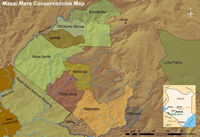 During January and February we (Petter and Joyce) spent some very productive weeks in the Mara ecosystem getting the pilot phase of Elephant Partners up and running. Our primary purpose during this trip was to learn as much as possible about the Mara elephants and the challenges they are facing, while fine-tuning the scope of the project and testing out equipment and technical solutions for data collection and upload. We visited five different conservancies and three group ranches, met up with many stakeholders and potential collaborators, trained quite a few conservancy scouts and guides and held lectures about elephants, their behavior and the Elephant Partners initiative.
During January and February we (Petter and Joyce) spent some very productive weeks in the Mara ecosystem getting the pilot phase of Elephant Partners up and running. Our primary purpose during this trip was to learn as much as possible about the Mara elephants and the challenges they are facing, while fine-tuning the scope of the project and testing out equipment and technical solutions for data collection and upload. We visited five different conservancies and three group ranches, met up with many stakeholders and potential collaborators, trained quite a few conservancy scouts and guides and held lectures about elephants, their behavior and the Elephant Partners initiative.
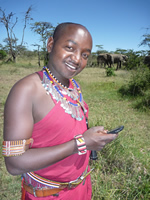 Joyce's trip started on Mara Naboisho Conservancy, where we plan to establish a base for the project. Mara Naboisho is a new 200 sq km conservancy, initiated by Norwegian-based Basecamp Explorer/Foundation and 502 Maasai landowners. Mara Naboisho is an amazing area in terms of wildlife and habitat, and together with neighbouring conservancies a crucial landscape for protecting the world famous wildebeest migration between the Serengeti and Maasai Mara as well as for general movement of wildlife, including elephants.
Joyce's trip started on Mara Naboisho Conservancy, where we plan to establish a base for the project. Mara Naboisho is a new 200 sq km conservancy, initiated by Norwegian-based Basecamp Explorer/Foundation and 502 Maasai landowners. Mara Naboisho is an amazing area in terms of wildlife and habitat, and together with neighbouring conservancies a crucial landscape for protecting the world famous wildebeest migration between the Serengeti and Maasai Mara as well as for general movement of wildlife, including elephants.
Joyce spent several days on Mara Naboisho training instructors of African Impact. The organisation offers volunteer work in Africa and Elephant Partners is on their list of opportunities. African Impact is also helping  us to test out techniques and equipment for monitoring elephants and sharing information.
us to test out techniques and equipment for monitoring elephants and sharing information.
During those few days together we added 47 new individuals to Elephant Partners ID registry and resighted quite a few who we had seen before. The most exciting resighting was the beautiful female f0096 who was last seen in 1998 40 kilometers away.
While at Mara Naboisho Joyce gave a lecture to a women's group and another to the newly graduated conservancy scouts. She also discussed the development of educational material by ElephantVoices for the Koiyaki Guiding School.
Driving west from Mara Naboisho Joyce travelled through Olare Orok Conservancy on the way to Mara North Conservancy. On the way she stopped to photograph some elephants and much to her delight she found two whom she had photographed and registered 20 km away on Mara Naboisho just days before and a ridiculously playful male.
On Mara North Conservancy Joyce was generously hosted by Karen Blixen Camp and spent three days training Cille Willumsgård, a young Danish woman who is collaborating with us as part of her Master's field work supported by Karen Blixen Camp. Petter joined Joyce and Cille there and we discussed the project with the Conservancy Manager, Marc Goss. 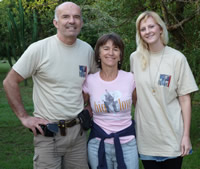 During the three days with Cille we added about 35 elephants to the registry and Cille has since then built the number up to over 150 individuals. She will be sending her photographs to us later this month so that these individuals can be incorporated into the overall Elephant Partners ID registry. It will be interesting to see how many of these individuals have already been registered. We know of at least two: a crazy looking female with 3 tusks (photo below) and a magnificent male (video below). However, Cille observed both of these individuals inside the Maasai Mara National Reserve rather than on Mara North Conservancy.
During the three days with Cille we added about 35 elephants to the registry and Cille has since then built the number up to over 150 individuals. She will be sending her photographs to us later this month so that these individuals can be incorporated into the overall Elephant Partners ID registry. It will be interesting to see how many of these individuals have already been registered. We know of at least two: a crazy looking female with 3 tusks (photo below) and a magnificent male (video below). However, Cille observed both of these individuals inside the Maasai Mara National Reserve rather than on Mara North Conservancy.
The photographs really help us to understand where individual elephants are moving, and we are very curious to know how far afield the elephants from Mara North go. These particular elephants face enormous levels of conflict with people. Understanding their movement patterns will help to mitigate the threats and ease the relationship between people and elephants.
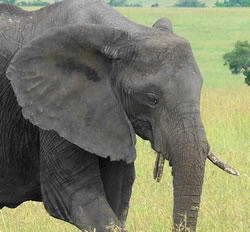 Mara female with three tusks - f0245. |
We left Mara North Conservancy and spent a day on Mara Conservancy, where we held discussions with manager, Brian Heath, and veterinarian, Asuka Takita, who has contributed hundreds of ID photographs to Elephant Partners. On our way out of the conservancy we met the magnificent musth male who Cille later photographed - the male in the video above right.
 By evening we were back on Olare Orok Conservancy, where we were hosted by eco-friendly Porini Lion Camp. There we held discussions with the Conservancy Manager, Rob O'Meara, introduced elephants and the project to scouts and guides and gave a lecture on elephant behavior and conservation to them. Naturally we also spent quite a bit of time just watching and photographing elephants. Among the many elephants we met was a resighting of f0004 who Joyce photographed in 1998 in Musiara. We also met a large group of elephants that included a female who had been photographed near Governor's Camp in 2007 by our friend Doug Aja! Each photograph is a piece in the jig saw puzzle!
By evening we were back on Olare Orok Conservancy, where we were hosted by eco-friendly Porini Lion Camp. There we held discussions with the Conservancy Manager, Rob O'Meara, introduced elephants and the project to scouts and guides and gave a lecture on elephant behavior and conservation to them. Naturally we also spent quite a bit of time just watching and photographing elephants. Among the many elephants we met was a resighting of f0004 who Joyce photographed in 1998 in Musiara. We also met a large group of elephants that included a female who had been photographed near Governor's Camp in 2007 by our friend Doug Aja! Each photograph is a piece in the jig saw puzzle!
From Olare Orok we spent a few more days back on Mara Naboisho before proceeding to Ol Kinyei Conservancy, where we discussed the Elephant Partners initiative with Manager, Sammy Lempusia. We were fortunate enough to meet an elephant family group who we then sighted again on Mara Naboisho several days later.
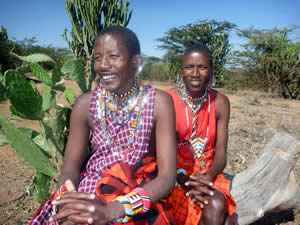 From there we drove on to the rather bumpy main road between Sekenani Gate and Narok, met up with Stephen Kisotu of Friends of Conservation and proceeded with him to Maji Moto Group Ranch. We spent three days with Stephen who introduced us to some of the opportunities (primarily the remaining corridors) and threats (mainly human-elephant conflict) facing elephants on the eastern side of the Maasai Mara. Stephen Kisotu introduced us to Maasai elder, Salaton ole Ntutu, and we more than enjoyed our stay at his Maji Moto Camp.
From there we drove on to the rather bumpy main road between Sekenani Gate and Narok, met up with Stephen Kisotu of Friends of Conservation and proceeded with him to Maji Moto Group Ranch. We spent three days with Stephen who introduced us to some of the opportunities (primarily the remaining corridors) and threats (mainly human-elephant conflict) facing elephants on the eastern side of the Maasai Mara. Stephen Kisotu introduced us to Maasai elder, Salaton ole Ntutu, and we more than enjoyed our stay at his Maji Moto Camp.
Salaton was well conversant with the problems facing elephants and people and together we discussed how to alleviate conflict by providing water for elephants away from the village (elephants come to the Maji Moto spring at night and depart early in the morning, endangering children on their way to school). We had fun and interesting visit to Enkiteng Lepa School, assessing how Elephant Partners possibly can contribute toward the conservation of elephants through education via the big network of schools in the Mara ecosystem.
| From Maji Moto we went on to Naikarra Group Ranch, where Stephen (with whom we stayed) introduced us to the remaining elephant corridors and the growing human-elephant conflict due to land being turned over to agriculture. Stephen explains the conflict in the short video clip (right), while we were visiting an area of new settlements in traditional "elephant country".
We departed Naikarra arriving back at Mara Naboisho in time to meet Richard Roberts who flew in from Ol Chorro Conservancy. Richard is setting up a rapid response team to reduce human-elephant conflict and related elephant mortality on the western side of the Mara. |
Joyce departed from the Mara the following day and spent the next day in Nairobi discussing Mara elephant plans with Iain while Petter remained in the Mara and got stranded in the bush with clutch problems! After sorting out the clutch and holding several more meetings Petter proceeded to Nairobi to initiate the building of online housing for all of the elephant information we hope to collect and share with you.
We look forward to working with the many people we met on our journey - a harambee spirit (Harambee is a Kiswahili word meaning working together for a common purpose) is vital for the conservation of the Mara elephants and a successful Elephant Partners!
We have started a Facebook page: http://www.facebook.com/ElephantPartners as a window to engage with anyone interested in the initiative, the Mara elephants and the Mara ecosystem.

